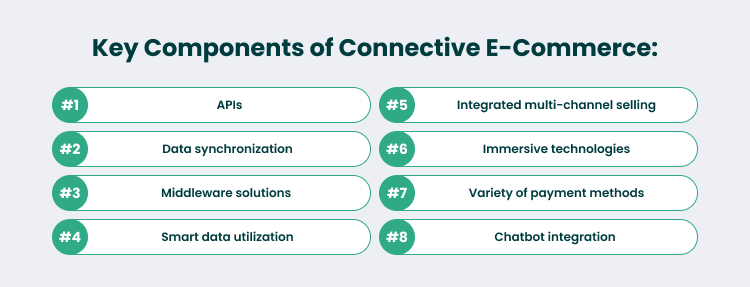Today, online retailers face many challenges that can impact their success and relationships with clients. From dealing with scattered shopping to difficulties in managing various channels, these problems can create a vague experience for online businesses and their audience. But there’s a solution that can help stay ahead of the pack. This is connective e-commerce.
Imagine navigating a labyrinth of disconnected systems, where every step presents a new obstacle. That’s a painful reality for many e-commerce platforms. Customers deal with inconsistent services, while retailers struggle with fragmented data and inefficient operations. But what if there was a way to simplify all these processes into one smooth infrastructure?
Connective e-commerce is that solution. It integrates various platforms, data sources, and operations into a cohesive system. Whether you’re experienced in e-commerce or just starting out, understanding the benefits of connective commerce is crucial for thriving in the market.
In this article, we’ll explain why connective e-commerce is a driving force of your e-commerce platform and how to develop it to benefit your online store. Let’s dive in.
What Connective E-Commerce Is And How It Works
Connective e-commerce is an advanced approach to running an online business. It focuses on seamless integration and communication between different elements of your digital store. This approach goes beyond the traditional online selling model. It involves the creation of an ecosystem where every part, from payment processing to customer service, works together without performance drops.
Connective e-commerce aims to design a digital environment, where data flows seamlessly, keeping information accurate and up-to-date. This simplifies operations, reduces errors, and improves customer experience.
Imagine a customer places an order on your online store. With connective e-commerce, the system automatically updates inventory levels, processes the payment, and sends an order confirmation to the client. At the same time, the data is synced with your CRM to update customer information and alert your warehouse team to start packing and shipping.
This connectivity ensures that every order aspect, from inventory to customer service, is synchronized. It minimizes errors, speeds up processing, and keeps information accurate, ultimately enhancing customer experience and streamlining your operations.
The Backbone of Connective E-Commerce
The backbone of connective e-commerce consists of components ensuring a smooth information flow and effective transaction management. Each element is vital for creating an interconnected, seamless e-commerce platform. Here are the core elements of connective e-commerce:
APIs (Application Programming Interfaces)
E-commerce APIs serve as the tools that enable communication between different software. They define how diverse applications can share information. In connective e-commerce, APIs help your website, inventory system, payment gateway, and other tools interact smoothly. Acting as intermediaries, they facilitate data flow between all parts of your online store.
Data synchronization
Data synchronization ensures that information remains up-to-date and consistent across different systems. For example, when selling products online, this information will be updated on all relevant platforms simultaneously. Data synchronization helps keep your online store running smoothly by ensuring all your systems have the latest and most accurate data.
Middleware solutions
Another component of connective e-commerce you may need is middleware solutions. Integration middleware acts as an intermediary between software applications, helping them interact. It ensures that your platform, inventory, payment systems, and other tools work smoothly, keeping your online store running as a cohesive system.
Smart data utilization
Your connective e-commerce should rely on smart data usage to truly understand market trends, customer behavior, and what your audience actually prefers. With advanced analytics and machine learning in place, you’re able to personalize the shopping experience, fine-tune your marketing strategies, and highlight products that feel timely and relevant to every shopper.
Integrated multi-channel selling
Connective e-commerce goes beyond just one sales channel. With integrated multi-channel retailing, businesses can reach customers on online marketplaces, social media, or even in brick-and-mortar stores. This expands your audiences and increases sales opportunities.
Immersive technologies
Immersive technologies like augmented reality (AR) and virtual reality (VR) sell experiences rather than just products. AR and VR increase the online shopping quality by allowing customers to try products before buying them.
Variety of payment methods
Connective e-commerce should offer secure and convenient payment options, including credit cards, digital wallets, and buy-now-pay-later services. Payment methods must cater to diverse customer preferences. The main thing is to implement robust security measures to protect sensitive customer data.
Chatbot integration
The cornerstone of connective e-commerce is AI in customer service. That’s why it is vital to integrate an AI-powered chatbot for real-time support. With this assistant, you can resolve issues and help customers during their purchasing process. This is an effective way to make your clients happier and encourage them to return to your online store.
All these components contribute to advancing your platform with e-commerce trends, ensuring better customer engagement and shaping the success of your online business.
The Potential Benefits of Connective E-Commerce for Your Store
As it was mentioned above, adopting connective e-commerce is a great way to streamline your store’s operations and improve your customer experience. It’s a smart move that helps your business succeed now and prepares for future changes in the e-commerce world.
Embracing connective e-commerce can provide you with the following potential benefits:
- It can streamline operations – Connective e-commerce simplifies your operations by reducing manual tasks and minimizing errors. This results in a faster, more efficient workflow, allowing your team to focus on larger projects instead of routine tasks. So, you’ll achieve higher productivity and increased profits.
- It can improve customer experience – With connective e-commerce, you can make buyers’ journeys smoother, from browsing and checkout to faster transactions and easier navigation. This leads to happier customers and greater trust in your brand.
- It grows with your business – As your website traffic, product range, or customer base increases, the system adjusts smoothly. This allows you to manage growth without major changes or interruptions, helping you take advantage and boost sales.
- It eliminates the need to hire staff – The connective e-commerce approach focuses on affordable, low-effort solutions that reduce the need for additional hires. For instance, instead of paying for a web developer, you can purchase a ready-made store template and design your online store yourself.
- It reduces financial investments – Connective e-commerce business models help cut costs on inventory and marketing, allowing you to sell online without significant capital or with minimal investment.
- It encourages experiments – Lowering startup costs allows you to test different brands and product ideas to see what works best. With reduced expenses, you could even launch multiple brands, increasing your chances of success.
- It reduces time to market – Ready-made solutions and vendor partnerships help you save time when launching your business. Unlike traditional methods, where you’d spend time building a website, stocking inventory, and running ads, these options allow you to start faster and test your business model sooner.
Contact us if you want to power your e-commerce business and unlock new growth opportunities.
How to Develop an Effective Connective E-Commerce Strategy: Key Steps
Designing an effective connective e-commerce strategy is a complex process that requires a detailed plan to follow. Here are the key steps to consider:
Step 1: Identify your niche
Start with market research and choose a niche with products that meet your audience’s needs. To check product popularity, you can use Amazon bestseller lists, Google’s Keyword Planner for search data, or examine how many businesses sell similar products on platforms like Amazon and Etsy.
Step 2: Choose the right e-commerce platforms
Picking the right platforms paves the way for setting up connective e-commerce. Start by evaluating software and tools for compatibility, scalability, security, and robust API features. Ensure that the platforms can easily share data and scale as technology evolves.
Keep these factors in mind:
- Cost: Choose a platform with free or low-cost plans to keep startup costs low.
- Ease of setup: Look for platforms with free templates to quickly launch without web development skills.
- Dropshipping: Pick a platform that integrates with your supplier to automate dropshipping.
- Sales channel integrations: Ensure it connects with free marketing channels like social media to boost sales.
- Features: Look for payment options, security, mobile-friendly design, good customer service, and hosting.
Step 3: Establish a solid integration strategy
A clear integration strategy is key to successful connective e-commerce. It involves planning how different parts of your system will connect and share data. This includes mapping data flow, identifying key touchpoints, and setting up processes for syncing. A solid strategy ensures smooth communication between systems, keeping everything running efficiently.
Step 4: Test for a smooth work
Thorough testing is crucial for catching and fixing any issues before fully launching connective e-commerce. This step involves testing various transactions, data flows, and possible problem scenarios. Testing helps ensure that the integration works smoothly, uncovers any hidden challenges, and allows for quick resolution of detected problems.
By carefully following these steps, you’ll ensure a smooth connective e-commerce integration. This approach helps your store run efficiently and provides a great experience for you and your customers.
Final Thoughts
Remember, integrating a solid connective e-commerce strategy requires more than just business skills and technical expertise. It’s about understanding your goals and choosing the right platforms to achieve them. As you move forward, fueling your online business with connective e-commerce will make it more efficient and responsive to client needs.
At Forbytes, we provide e-commerce development services to create seamless e-commerce experiences and turn your visitors into loyal customers. Our team builds solutions that address challenges and meet user needs. From responsive online shops to automation tools, we ensure your venture is scalable, secure, and set up for success.
Ready to boost your e-commerce? Schedule a free consultation to discover how we can help increase your sales and improve your customer experience.










